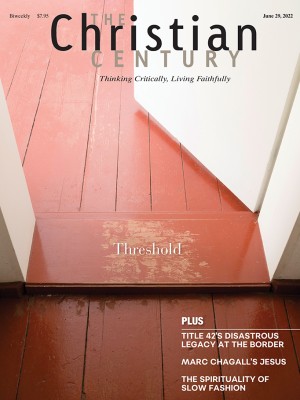The spirituality of slow fashion
I have found joy reusing, recycling, and repairing clothing.

It used to take less than five minutes for me to acquire a new shirt. A quick detour through the clearance section at Target (when I was supposed to be shopping for peanut butter and deodorant) and I could scoop up a fall flannel for $5.98. Or with a few quick clicks through the J.Crew 40 percent–off sale, a floral-print camisole was in my virtual cart and set to be shipped the next day.
That’s not the case anymore. Three years ago, I put the brakes on my fast-fashion consumption. Instead, I’ve learned to slow down and find joy in re-styling the clothes that are already in my closet. Or reach out and connect with a friend and swap a few seasonal wardrobe items. Or embrace the thrill of the hunt with a trip to the local thrift store for vintage jeans and a pullover sweater.
Read our latest issue or browse back issues.
This is the practice of slow fashion: it’s about intentionally reusing, recycling, and repairing clothing. Fast-fashion culture instead prioritizes trends that change quickly and wardrobes that can be turned over every season. This buy/wear/dispose model might have made fashion more accessible beyond the runways of Paris and the shops of Fifth Avenue, but it’s also consuming energy, water, and raw materials at a rapid pace.
Everyone wears clothes. (Hopefully, you’re wearing some right now!) Clothes can be a sign of vanity and an act of self-expression. They are both universal and particular, a connector and a divider: each person participates in the incarnational act of getting dressed every day. Christianity is an embodied faith; our souls and bodies are not separate. And how we clothe ourselves can be a spiritual practice. Fashion can be more than a noun in our lives—it can be a powerful verb.
This year’s contestants on the popular reality show Love Island will dress in secondhand clothes from eBay. The idea is to invite viewers to consider the impact of their clothing choices by adding one or two pre-loved items to their wardrobe. According to Harper’s Bazaar, the resale market is growing 11 times faster than traditional retail, and by 2030 it is projected to be twice the size of the fast-fashion section. Younger Americans are driving this shift.
I’ve learned to pause before pressing the “buy now” button and to contemplate who is bearing the true cost of my cheap shirt. It’s staggering to think that my expedient wardrobe decisions could be one of the leading environmental factors in the climate crisis today. Every second, one garbage truck full of textiles is taken to a landfill. Each year, clothes release half a million tons of microfibers into the ocean, equivalent to more than 50 billion plastic bottles. It takes 2,700 liters of water to make a single cotton shirt. And fewer than 2 percent of garment workers earn a living wage.
In the Bible, starting in the garden of Eden, God clothes people. God also invites us to clothe others: “I was naked and you gave me clothing” (Matt. 25:36). Being intentional about how we clothe ourselves and others is a way we join God in fashioning a world of hope and possibility.
I volunteer at a Lawrence, Massachusetts, organization called Uncommon Threads. The group’s mission is to empower women through clothes donated by individuals or small companies. One afternoon I met a woman there who was living in a YMCA shelter with her three young children. She had a restraining order against her husband and lived in fear for her safety and well-being.
I learned that she wanted bright, colorful clothes, and I worked with other stylists to select pieces that made her feel good: pink sandals, a matching top, some sparkly earrings. It was her one hour not to worry about her children, her job, her housing situation, or her safety. When she looked in the mirror to see her new secondhand outfit, she smiled and stopped to take in her body from different angles before declaring, “I love it.” For that moment, in the mirror, I suspect she saw the imago Dei: beautiful, beloved, and worthy of belonging.
Clothes can be a tool. They can be a tool of assessment and comparison to judge how others measure up—particularly in the realm of social media and among women. But clothing can also be a tool of empowerment, creativity, and self-expression.
And much to my surprise, I’ve found clothes to be a tool of connection. In the midst of Lent, I was lamenting the lack of creative outlets in my life. Parenting and pastoring did not allow space for a weekly pottery class. So, although I was supposed to be on a social media fast, I decided to start sharing selfies sporting my thrift shop finds. And quickly, I stumbled upon a tiny corner of Instagram where people of all different shapes and sizes, genders, ages, and races are sharing about their passion for sustainable shopping and secondhand clothes. A few times a week, I take the time to post an outfit of the day (#ootd) under the handle The Reverend Wears Prada and to cheer on others who are making the shift to slow fashion. My online pseudonym is not entirely accurate; while I am an ordained United Church of Christ minister, I don’t own any Prada, though perhaps one day I will find some on the racks at Goodwill.
In embracing the slow fashion movement, I have found myself joining God in fashioning a world where I honor my sacred embodiment, care for God’s creation, and celebrate the beauty of self-expression. Once I exited the fast-fashion speedway, I discovered that it’s not about less, it’s about more—more joy, more play, more connection. For who knows? If the ’90s floral sundresses have returned, the ’70s jean jackets are back, and the ’80s wide plastic sunglasses are hip again, circular fashion might save not only the environment but our souls as well. After all, God’s grace, love, and compassion will never go out of style.
A version of this article appears in the print edition under the title “Clothed with joy.”





